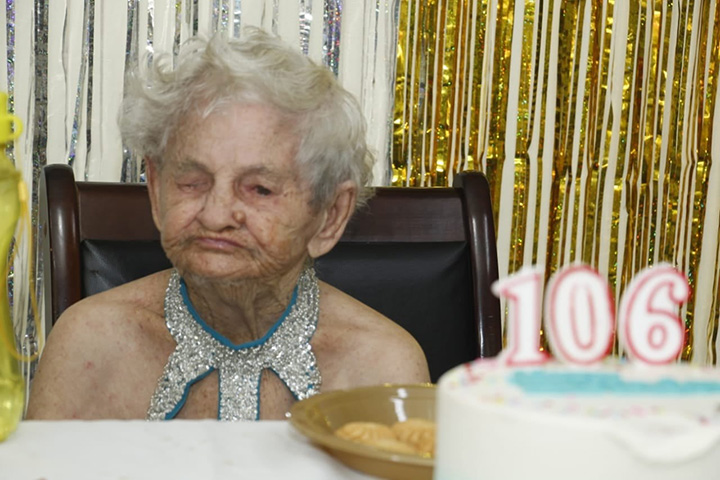
There is simply no one left to remember if little Zorie De Mattos shivered from a fever, caught a chill and a cold, or showed even the slightest sign of sniffles in what became known as the “Spanish flu.”
Mortality was particularly high in children under five years old. We know she lived through not only the deadliest outbreak, caused by an H1N1 virus that walloped the colony and the world in two waves from 1918-1919, but also everything else since, starting from “the war to end all wars,” to the devastating loss of her parents, her sister and closest kin, and then last May, to a sudden infection by the then newly-discovered coronavirus disease that has gone on to kill about 2.7 million (M) people.
On January 1, 2021, as we cautiously marked the New Year, the petite Miss De Mattos wore a saucy sky-blue halter dress with sparkling sequins that showed off her smooth shoulders, joining devoted carers and a few others from Ward Six at the Palms Geriatric Home to celebrate her 106th birthday with a matching layered-iced cake, topped with individual candles of the three numerals.
An awed nation grinned and cheered, as Guyanese from all over, congratulated the senior who has become a legend online and off, as we offered gratitude and blessings in a dark and difficult time, for yet another milestone that marks the feisty lady as a valued member of a most exclusive international club.
Ms. De Mattos is the extraordinary soft face of a smiling survivor, having made it through an initial attack of COVID-19 with unique genes and the built-up resistance that comes from a tough lifetime of conquering illness and adversity in the South American tropics.
Her chances of living so long were also bolstered by the dedication and diligence of a small band of staff and a team of vigilant Health Ministry doctors who oversee the public institution in Brickdam. Ms. De Mattos has stayed there as a ward of the State since 1969, nearly half of her life, and almost all of mine, after being reportedly left by an older brother who was unable to continue caring for her, only three years from when British Guiana finally gained independence.
With a shock of wavy white hair, and the sharp glint in her single clear brown eye, a composed Zorie has quietly joined an incredible grouping of only 75 verified complete cases, as recorded by gerontology experts, of the globe’s most elderly COVID-19 survivors. As of yesterday, there were at least 235 people aged 105 or over, reported to have tested positive for the disease, but many have died and other patient cases are noted as incomplete or pending.
Historians estimate some 12 000 people or nearly four percent of this country’s population died in the 1918-1919 flu pandemic. About 500M people or one-third of the world’s population became infected with the virus, as the international death toll rocketed to 50M with high mortality in the 20-40 age group. According to British Professor, David Killingray, Guyana and Belize were terribly affected, with a mild outbreak initially noted here in July 1918, likely arriving on a ship from Trinidad and Tobago, escalating into “epidemic proportions” across the colony.
“The railway, coastal craft and the river system speeded the spread of the infection which took hold in the closely crowded housing of Georgetown, Suddie and New Amsterdam, and among labourers in the densely packed ill-ventilated and damp huts of sugar plantation estates strung out along the low-lying coast and river mouths” with fleeing labourers helping to spread the influenza virus, he said in a published paper.
As the globe grapples with the latest killer virus, we know that masks are back, social distancing is in, and handwashing is compulsory. So far the world’s oldest known authenticated COVID-19 victim is the 113 year-old Marie-Florentine Jousseaume, who passed away in December last year, while the oldest confirmed COVID-19 survivor is another astonishing Frenchwoman, the supercentenarian Lucile Randon, renamed Sister André, a now-blind Catholic nun, who self-isolated following a COVID-19 diagnosis but did not experience any symptoms of the virus, managing to observe her 117th birthday in style on February 1.
Sister André is the world’s second-oldest validated individual alive, behind the Japanese record-holder the ever-curious Mrs. Kane Tanaka, who has twice survived cancer, loves fizzy drinks and plays maths games daily having enjoyed her 118th year on the planet on January 2. A third woman, the 106 year-old Briton Mary Nicholson has survived the virus twice. A supercentenarian is someone who has reached the magic human age of 110, achieved by about one in 1,000 centenarians.
“[I] didn’t even realize I had it,” Sister André told a French newspaper. Likewise, Zorie, who loved helping out at the Palms, made headline news when she emerged the oldest among three elderly residents, to have out-lasted the virus. She showed mild to moderate symptoms before quickly recovering, as two others died, and several more between the ages of 55 and 90, took longer to recuperate. Nurses said that the otherwise-healthy Zorie had a fever and some pains, but they ensured she drank lots of fluids, followed a specialised diet and received her Vitamin C boost daily. Sporting a rhinestone tiara and a sceptre, she happily posed for photographs in her “I beat Covid-19” tee-shirt, proving to admirers that a miracle did occur in Ward Six.
Scientists are intrigued by the deepening mystery of how so many elderly patients like Zorie De Mattos have managed to conquer a widespread infection that has snatched the young and the seemingly healthy. The United States’ Centers for Disease Control and Prevention put the risk of dying due to COVID-19 at 630 times higher in people over the age of 85 as compared to young adults ages 18 to 29. Some 121M people have been infected, with 68.6M recovering, but cases are again on the rise with Guyana revealing 51 new cases and another fatality yesterday of a 66 year-old female, as the death toll inched to 209.
Reporting on surprising research that supercentenarians have higher-than-typical concentrations of a particularly rare type of “T helper cell” in their blood, the Live Science website explained these immune cells may offer special protection against viruses, leaving the very old in remarkably fine health throughout their life spans.
In a small study of Japanese supercentenarians, the experts found a large proportion of the participants’ immune cells were made up of the “T helpers” that are cytotoxic, meaning they can voluntarily attack and kill dangerous invaders even though they usually act as instructing commanders. While just under three percent of such cells in young people had this ability, in supercentenarians, that number soared to an astounding quarter or 25%.
As geneticists continue studying the treasured genomes of centenarians to determine key traits that may contribute to healthy aging, in Zorie De Mattos’ case if such an examination is ever allowed, her unknown family should be honoured to learn that they are related to an exceptionally spunky Guyanese, who is living and thriving through yet another challenging pandemic. In the words of a nurse, “My girl Zorie (is) the best patient I had at the Palms…”
ID tries not to think of ever-evolving variants and the shortage of vaccines, choosing to hear a Brazilian specialist who declared, “When people ask me why these people are surviving, I usually answer that it’s probably precisely because they are centenarians.”
